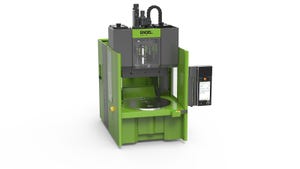Weekly Resin Report: No End in Sight for Price Hikes
PE contract prices have risen some $0.60/lb during the past year, and more increases are on the table.
July 14, 2021

The spot resin markets continue to maintain their lofty levels. Trading activity began to pick back up after a typically quiet end to the second quarter. Completed volumes at the PlasticsExchange were heavily slanted toward polyethylene (PE) over polypropylene (PP), largely caused by still challenging supplies, reports the resin clearinghouse in its Market Update. While the market has seen a wide range of prices, it showed further consolidation, as off grade, representing the lower part of the pricing spectrum, continued to rise, while spot prime, on the top end of the market, remained flat. Ever-rising contract prices also ate further into the premiums that spot material established in the aftermath of the freak mid-February storm that swept through the Houston area disrupting production.
While some force majeure conditions and material allocations remain in place, resin production has returned for the most part, and can even be considered robust. However, after fulfilling contracts, producers are holding back resin to rebuild inventories, leaving little resin available for spot sales. There are still key factors to consider for the latter half of this year, like an active hurricane season, strong energy futures, electricity grids at capacity during the summer heatwave across the country, supply-chain interruptions, and prohibitively high domestic and international freight rates. Any additional impacts on resin supply can bring the market into new record-high levels. In the meantime, resin producers are also looking to push through another set of price increases for July, with some already nominated for August.
Another price increase on the table for July contracts.
Spot PE trading volumes improved from the prior week, but were still a tad light. Average prices held steady with an ongoing firm undertone. The flow of offers at the PlasticsExchange trading desk remained slow as the third quarter was just getting underway, and — Surprise! — another price increase was on the table for July contracts. Although official supply allocations for July are largely still in place, conditions have improved and larger processors are now getting much of their needs fed directly by producers. Other buyers that still need to tap the spot market are finding thin availability, but at only modest premiums compared with rising contract prices. Although the frantic pace has subsided, most prime PE grades are still scarce. Offers for injection-grade PE, whether it’s high-density (HD), low-density (LD), or linear-low-density (LLD), are scooped up in a heartbeat. Spot supplies of HDPE blow-molding resins have mostly been derived from overseas markets, while North American produced film grades have begun to show in limited volumes, according to the PlasticsExchange.
Shipping delays and freight costs kneecap PE imports.
PE imports have been crimped by long shipping delays and astronomical ocean freight rates, which have essentially closed much of the arbitrage incentive. Incremental export demand for US product remained good from Mexico and Latin America, while producers continued their higher volume direct/contract export programs. North American PE producers successfully implemented June contract price increases of $0.05/lb for all commodity grades, extending the upward trend for a seventh consecutive month. The June price hike was driven by limited supply and strong buyer demand, with premium spot prices paving the way. PE contract prices have relentlessly increased 11 of the past 13 months, only pausing during October and November before resuming their extended rally. Prices have risen some $0.60/lb along the way. The heat is on for another increase in July, with contract initiatives of $0.03/lb to $0.05/lb on the table. Many suppliers remain on force majeure or sale allocation programs. PE contracts typically are settled toward the end of the month.
Spot PP prices held steady for a second consecutive week. Completed orders were limited by slack interest because of the US independence holiday, as many processors took an extended break at the onset of the third quarter. Domestic PP prices are not far off from record highs. Homo-polymer was priced a nickel from its $1.45/lb record set in March, while co-polymer was just a penny off its $1.51/lb high achieved in June. Co-polymer also kept its $0.10/lb premium to homo-polymer PP, which has been intact since mid-May. The spread between those two grades has not been anywhere near its typical two to three cent level since mid-September 2020. A range of off-grade railcars were seen last week, from near Prime and transitional melts to rougher wide spec. Offers for Prime truckloads were also made available through imports mostly located on the east and west coasts and to a lesser extent in Houston. Make no mistake, however, cautions the PlasticsExchange: PP material still is not easily obtainable.
Domestic PP inventory slowly rebuilds.
PP production has returned to pre-storm volumes and one major producer lifted its force majeure that had been in place since February, but its sales control program remained in place. There are still at least five other PP producers with allocation programs, and most contract buyers are only getting reduced supplies, some still at minimum levels. The domestic inventory rebuild is slowly progressing and has a long road ahead until producers are collectively in a flush supply position, reports the PlasticsExchange. In the meantime, upward pricing pressure persists: July increases from $0.03 to 0.05/lb are on the table, in addition to a change in July propylene monomer, which is already pointing higher. Two suppliers have also stepped out with a nickel increase for August.
Although commodity resin prices are near record levels, sticker shock has worn off and higher costs have been largely pushed downstream to consumers, where demand remains robust. The market is still dealing with the trauma caused by the series of production disruptions beginning with last August’s hurricanes, and while supply conditions are just getting back toward normal, the heart of the storm season is just ahead. Resin is still hard to source. If relatively reasonable deals can be found, stockpiling a few extra pellets, like producers seem to be doing, might be a worthwhile buffer in case harsh weather takes petrochemical and plastics capacity offline again.
Read the full Market Update, including updates on energy futures and feedstock pricing, on the PlasticsExchange website.
About the Author(s)
You May Also Like


